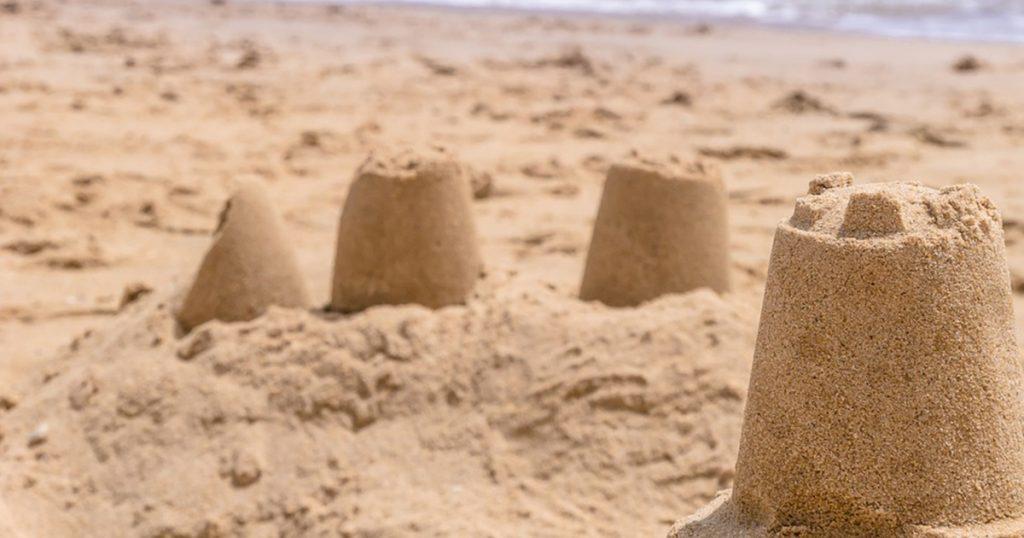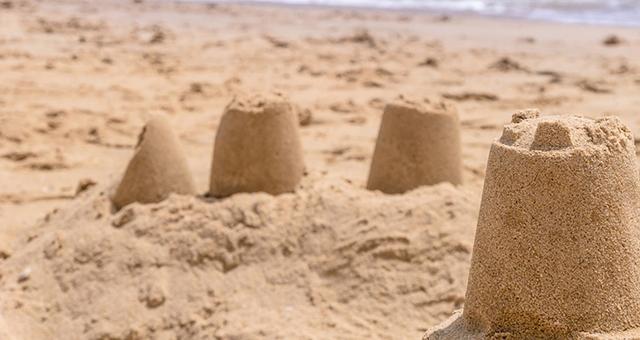
While building sand castles, there is a certain kind of wet sand that is perfect for it. When there is too much water in your bucket the mixture is too soupy. When there is too little water in your bucket the sand won’t hold a shape and just crumbles. How does the perfect mixture of sand and water work? Surface tension is the attraction that happens between water molecules. Water molecules are attracted to each other. The surface of water has an elastic quality because the molecules are hugging close together. This is why some insects can walk on water.
Water is made up of two kinds of atoms, hydrogen and oxygen. The name for the water molecule is H20, it has 2 hydrogen atoms and 1 oxygen atom. Water molecules are attracted to each other because hydrogen atoms and oxygen atoms are attracted to each other and hug close together really tight. This is called cohesion. The molecules hug so close together they don’t want to touch other molecules around them. That’s why a bubble or a drop of water is round and only rests a small part of itself on a surface when it lands.
When you add sand to water, the surface tension of the water forms little elastic bridges between the grains of sand. When the ratio of sand to water is just right these bridges are the perfect strength for building sand castles. In today’s experiment you will be able to watch these bridge at work and figure out the best recipe for building sand castles.
What You Need
- 12 Dixie Cups
- Sand
- Water
- 25 Pennies
- 4 Large Plates
- Large Bowl
- Measuring Cups (1/4, 1/3, 1/2, 1)
Instructions
You are going to test what ratio of sand to water is the best one for building a strong sand castle. Label each plate – label the first one 1/4 cup, the second one 1/3 cup, the third one 1/2 cup and the last one 1 cup. For each trial you are going to use 1 cup of sand. The variable in this experiment is going to be the amount of water you add to the sand. For the first trial mix 1 cup sand and 1/4 cup water in the bowl.
Fill three dixie cups with this mixture and turn them over to make small sand castles in the plate labelled 1/4 cup. Do the castles flatten or stay formed like the dixie cup? If any of them stay formed, stack pennies on top of the little castle one at a time until the little castle collapses. Write down how many pennies each little castle could hold. Repeat this test using 1 cup sand and 1/3 cup water, 1 cup sand and 1/2 cup water and 1 cup sand and 1 cup water. Keep track of your results on a chart like this:
| Amount of Water | #pennies trial #1 | #pennies trial #2 | #pennies trial #3 |
| 1/4 Cup | |||
| 1/3 Cup | |||
| 1/2 Cup | |||
| 1 Cup |
One cup of sand to 1/3 cup water is what worked for us!
It turns out that water molecules attract to each other and they ALSO attract to sand. If you have a good balance of sand to water…nice and sticky…then you get a strong sand castle. When there is too much sand the mixture is too dry and the castle crumbles. If there is too much water the mixture is too wet and oozes all over the place.
Websites, Activites & Printables
- NASA: The Physics of Sandcastles
- Sand Castle Physics Revealed
- Sand Castle Central
- USGS Water Science School: Surface Tension
- Video: NASA STEMonstrations – Surface Tension
- Video Khan Academy: Surface Tension

You can also ask a math and science expert for homework help by calling the Ask Rose Homework Hotline. They provide FREE math and science homework help to Indiana students in grades 6-12.
e-Books and Audiobooks
Use your indyPL Library Card to check out books about Science Experiments at any of our locations, or check out science experiment e-books and audiobooks from OverDrive Kids right to your device! If you have never used OverDrive before, you can learn how to use e-books and learn how to use audiobooks.
Need more help? Ask a Library staff member at any of our locations or call, text or email Ask-a-Librarian. Additionally, the Tinker Station helpline at (317) 275-4500 is also available. It is staffed by device experts who can answer questions about how to read, watch and listen on a PC, tablet or phone.
Surface Tension Projects from Bubbles to Sand Castles
What do bubbles and sand castles have in common? Surface tension! Learn about the amazing science of water and how it makes both bubbles and sand castles “stick” by checking out one of these books. e-Books are also available!
